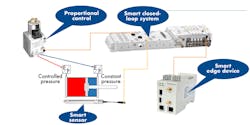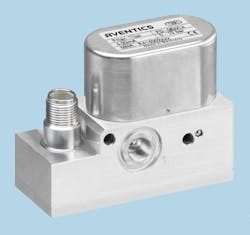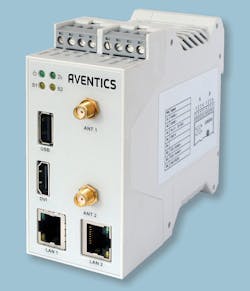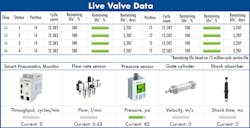IIoT-Enabled Pneumatics Improves Packaging Operation
Lately, it seems that the Industrial Internet of Things (IIoT) is like the weather: Everyone talks about it, but no one does anything about it. Emerson recently had an opportunity to implement a pneumatics IIoT project that produced measurable improvements in an agricultural processing plant that was encountering some challenges in its packaging area. Rather than installing all-new machinery with a lot of capital investment, Emerson focused on key areas that could be improved using smart pneumatic components.
Throughout the plant, bags of seed were being filled inaccurately, often by more than 5 lb in each 75-lb bag. Product flow through the plant was uneven at best, as seeds with sticky surfaces would constantly clump together in the dispensing silo, causing inconsistent product flow and “traffic jams” that alternately flooded or starved downstream processing stations. As a result, bags either were not filled enough, or too much seed was provided so that bags were overfilled.
Over the years, the plant had adopted several “workarounds” to address problems that came up daily. For example, if seed clumps became stuck during the dispensing process, workers would use large plastic hammers to break up the jam. If that was unsuccessful, another option was to use large threaded rods to poke around inside the hopper to free the seed. None of the practices was efficient or safe. In addition, these remedies often damaged the seeds or stripped off coatings.
Worst of all, the plant was incurring overtime charges to meet production quotas. Workers had to manually refurbish bags that were under- or over-filled—removing them from the line, opening them, and pouring the contents back into a secondary line to be repackaged.
Emerson’s solution addressed these issues with retrofits, costing a fraction of the investment required for new equipment. The approach relied on the traditional strengths of pneumatic systems, combined with the sensing and data collection capabilities of Emerson’s IIoT-enabled pneumatic components.
Analysis Focuses on Silo Gates
The plant relied heavily on material handling systems to move the seeds through the production process. The plant had an abundance of conveyors, all of which were equipped with sensors detecting fill levels, backpressure, temperature, and humidity—measurements that relate to the friction of the product and, thus, include the speed with which the product moves through the plant.
A typical agricultural bulk processing plant may contain 30 to 50 hoppers or silos throughout the facility, each with a gate that opens and closes to dispense product for the next step. In this particular application, the seed went to one process for coating, then it was stored elsewhere before going to the final hold area, onto a conveyor, and, finally, into the bagging system.
The process relied on open-loop feedback components that simply turned on and off. The plant had sensors in place but recorded information that was not being utilized. And because the gates were just opening and closing on command, flow of product through the plant was uneven at best, and disruptive at its worst.
Working with the plant engineers, Emerson determined that both the inaccuracies and the bottlenecks throughout the plant occurred at the dispensing gates, which were opened and closed pneumatically. A valve feeding an NFPA tie rod-style cylinder positioned the gate as it moved back and forth like a guillotine to choke off or open up the flow of product. Sensors on the cylinder simply reported whether the gate was open or closed based on the location of the piston. Therefore, the valve could not vary the position of the gate cylinder to regulate product flow according to the demand downstream.
When a gate was closed, product would build up behind it. Because the product was often sticky, materials clumped up before entering the product flow, often getting into the final packaging. When a clump got into a bag, the package had to be opened and refurbished—a labor-intensive process.
Emerson proposed a plan to migrate away from the plant’s current open-loop system to an intelligent, IIoT-based closed-loop layout that allows proportional positioning of the silo gates, thereby maximizing on-demand product flow.
IIoT-enabled Flow System
Emerson proposed a plan to migrate away from the current open-loop system to an intelligent, IIoT-based closed-loop layout that allowed the positions of the gates to vary. By permitting more than two gate positions—not just open or closed but varying the position from 0% to 100%—the system enabled better control for the flow of seeds entering the conveyor.
It started with an Emerson Aventics ED02 proportional control valve that balances the pressure on both sides of the piston and, therefore, the force. Increasing or decreasing pressure on either side provides a consistent, smooth motion, allowing a discrete actuator to act more with proportional positioning capability. The positioning system is extremely precise. Over a range of cylinder sizes, a repeatable high accuracy of 1% of stroke can be achieved using the ED02 valve. However, positioning becomes even better with smaller bore cylinders with shorter, controlled strokes because there is less air volume to control.
A repeatable high accuracy of 1% of stroke can be achieve over a range of cylinder sizes using the Aventics ED02 proportional control valve.
To provide that functionality, the machine’s main controller sends a command signal to the proportional valve. A feedback device—in this case an Aventics SM6 position sensor reading the location of the magnet within the piston—identifies the position of the cylinder within its stroke. The position sensor sends that information into a fieldbus-connected module running an embedded PID loop inside of it. The PID loop compares the actual real-time position via the fieldbus connection against the setpoint established by the user, and calculates the pressures required to change the position via the proportional valve. The sensor then confirms that the gate is in the proper position. Finally, an Aventics Smart Pneumatics Monitor (SPM) takes in all this live information as the gate valves move back and forth.
Bolt-on position transducers send information into a fieldbus-connected module running an embedded PID loop inside of it.
The new design removed a level of complexity by eliminating separate in-line valves and mounting them in manifolds that have common inlets and exhausts. All system components are enclosed in a simple bolt-up/hook-up control cabinet to minimize installation and commissioning times. Each enclosure controls four gates.
The Aventics Smart Pneumatics Monitor takes in all the live information as the gate valves move back and forth. Algorithms for AI give valuable analytics information, improving overall equipment effectiveness.
The IoT hub is also connected to the control network to review data from the process. Using EtherNet/IP, the system gains access to the plant’s distributed control system and other information. As a result, the system is no longer simply an on-off device. Instead, it passes data to the main controls for the plant and accepts position commands from the control system.
The system has an edge device on one side; the other has a PLC that provides intelligence locally, so it does not have to communicate outside the system. An edge device provides entry into an enterprise or service provider core network. Examples include routers and local area networks. If needed, though, it could also push the information out to the cloud and share it globally, allowing management to assess the overall equipment effectiveness (OEE) throughout all the plants and review why one plant might be running better than another.
Better Control and Efficiency
The new solution provides better control of the flow of seeds onto the conveyor, which prevents starvation of the downstream packaging system and increased OEE. More importantly, it collects data from the IIoT system, showing the average-sized openings of the gate valves while the system is in use. That information has been used to further improve the control system programs. In addition, the system provides critical information on system performance—for example, measuring valve life so the operator knows whether a valve is performing within specification. It shows cycle counts and the life remaining on every valve on a manifold.
The closed-loop system also monitors air pressure to determine throughput and flow requirements. If flow rates wander up or down, it could mean a change of state and that something in the process has changed. For instance, misalignment of a gate could cause additional friction. None of this information was visible with an open-loop system.
Goals Met and Exceeded
The new product flow system addressed several company goals:
Overtime reduction—By eliminating the overfilling and underfilling, the plant cut more than two hours of overtime per day.
System complexity—The system is less complex than the previous approach and is easier to maintain.
Productivity—The plant achieved approximately a 15% increase in the number of bags per hour it could process.
Accuracy—The accuracy of the filling process improved from ±7% to ±0.5%.
Overall equipment effectiveness —The system improvements result in a >15% improvement in OEE.
Safety—The new system eliminated the use of hammers and poker sticks to break up jams.
In addition, as the system began to collect data, plant personnel found some unanticipated benefits. One reading showed that a gate was typically in the 15% open position for 90% of the product moving through the system. But every now and then the gate valves would open to 60%. Working with Emerson, the plant engineers determined that as seed size varied, the gate valve automatically compensated for the size difference. The system provides flow path data that, when analyzed, allows the system to determine on its own that the 60% open position was preferable, based on the downstream requirements.
Benefits of Combining Traditional and New Capabilities
Being able to use proportional pneumatic control technology to position the gate anywhere within the stroke was a key advancement, allowing better control of the flow of seeds entering the conveyor system. The new system eliminates traffic jams and product clumping. In addition, it is less complex than the previous approach and requires far less maintenance.
This typical dashboard from the system not only shows throughput, flow, pressure, and velocity of the cylinder, but it also provides live valve data indicating the cycle count, bearing wear, and life remaining on the valves.
Using the data collection capabilities of IIoT-enabled components, the system allows plant management to be proactive about maintenance, relying on cycle counts and other live valve data. It also reduces the need for overtime and increases OEE more than 15%. The final solution combines the strengths of pneumatic actuation with new smart capabilities and IIoT integration, providing actionable data without investing in large capital expenditures.
Chris Noble is manager, Business Development for Food and Beverage/Packaging, and Mark Densley is director, Business Development for Automation Solutions, both at Emerson Electric Co. For more information visit http://www.aventics.com/us/en.







